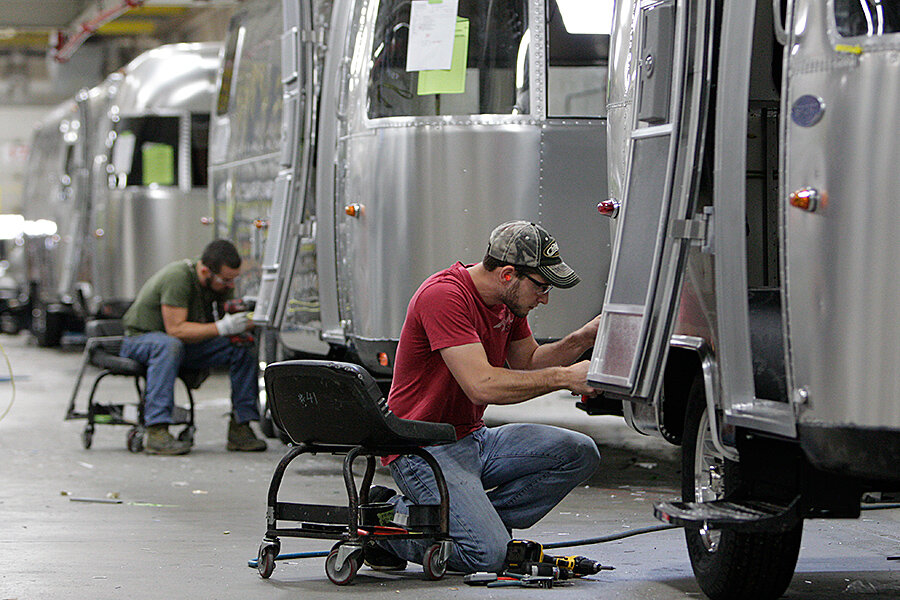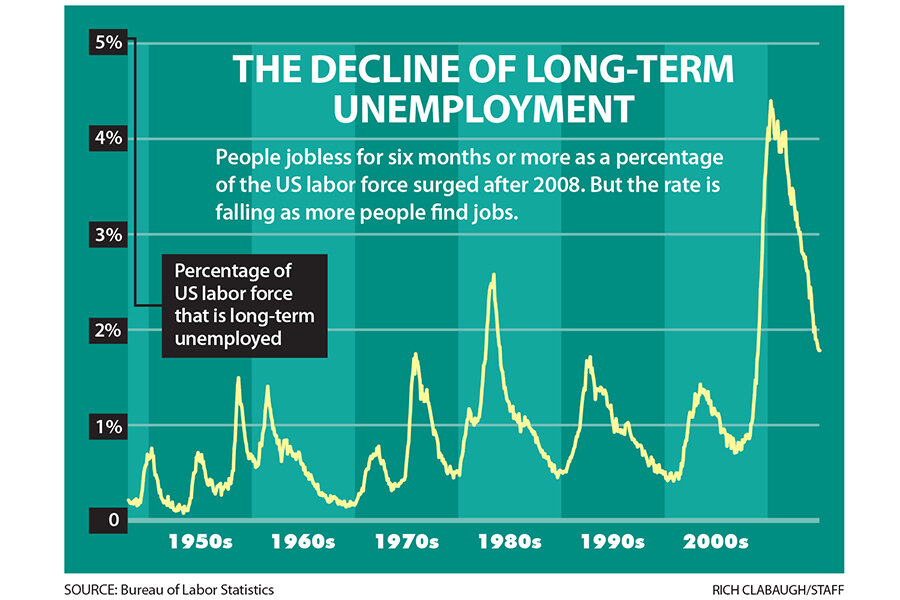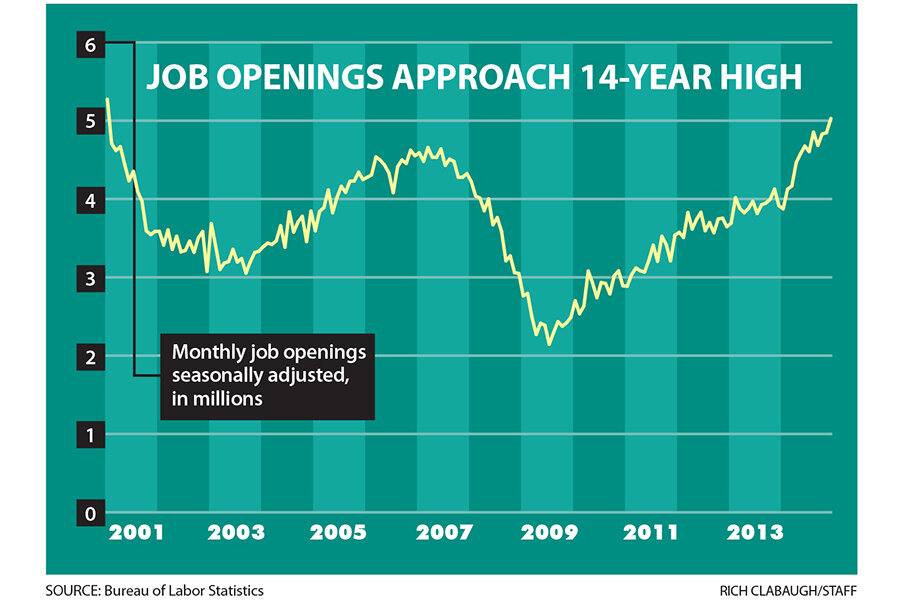Here come the jobs, finally
Loading...
| Washington
Trevor Parkes has been through the tunnel called unemployment in post-recession America and come out the other side. In the summer of 2013, he moved from Texas to Tennessee so his family could be closer to his wife’s parents. But when his new job evaporated with a layoff after just four months, Mr. Parkes was in trouble: unemployed in a difficult job market, edging toward age 50, and with two kids moving through school.
Not least among his challenges: He was still a newcomer to the Nashville area, with few friends or connections to turn to for support. “I was basically terrified, because I didn’t know anyone here,” he says.
Even with his wife working in youth ministry, the year that followed was one of emotional turmoil. Parkes tried it all. Temp work. Networking with other parents at his kids’ school. Contacting former employers. Mining online job boards. Each week, more résumés went out into the void.
Then this past fall, something changed. First came a small regional bank that actually wanted to interview him. Not long after came a call from the very bank that had laid him off. It was starting a new flood insurance underwriting division and hired Parkes to be part of the team.
The job means new confidence and financial security for Parkes and his family. It also represents a larger story of employment revival in the US economy.
Today’s US job market is healthier than you might realize. True, the recovery is incomplete. Even a good job market today won’t mean conditions are easy for US workers.
Yet the progress is real. And crucially, it’s helping to address one of the defining features of the Great Recession and its aftermath: the large number of people who are long-term unemployed and in many cases at risk of dropping out of the workforce altogether.
An improved job climate has, more broadly, revived economic spirits across America. For the first time since the Great Recession officially ended some 5-1/2 years ago, Gallup and CNN polls find a majority of Americans having a positive view of the economy.
Last year saw the strongest US employment growth since 1999, and the official US unemployment rate has fallen to 5.7 percent of the labor force as of January, down from 6.6 percent a year before.
“It’s certainly good news that payroll growth has eliminated a lot of the employment gap that resulted from the recession,” says Andrew Levin, who is joining the economics faculty of Dartmouth College. “But at the current pace of job creation, another 18 months to two years will probably be needed to reach full employment.”
In fact, even as the undeniable gains give the United States lower joblessness than many European nations, the set of remaining challenges is also clear:
• Middle-class incomes had been stagnating and inequality widening even before the recession. Those trends have now become central political questions, gaining attention from Republican and Democratic leaders alike in the run-up to a presidential election in 2016.
• From robots to smart phones, technology has opened new opportunities for consumers but is also disrupting traditional occupations. Economist Tyler Cowen distilled the worry in a 2013 book, “Average Is Over,” forecasting a future in which an educated elite pulls increasingly far ahead of everyone else.
• As the US emerges from the most protracted jobs bust since the Great Depression, a historically high number of working-age civilians are still without work or underemployed. Some have part-time jobs rather than the full-time ones they hope for. Some have grown so discouraged that they’ve stopped even looking for work.
One key worry is that many of the recession-sidelined Americans have become so detached from the workforce – losing skills, connections, marketability – that they may never work again.
Reviving the rate of labor force participation (the share of US adults who are working or wanting to work) may be a vital measure of whether America is really nearing “full employment.” That’s why, at this point, a month in which the unemployment rate edges up isn’t necessarily a bad thing – if it’s a sign of more people being drawn into the job hunt.
Economist Stephen Rose of George Washington University sees the challenges, but he also cautions against buying into a view of long-term pessimism. Time and again, he says, forecasts of a grim future have emerged in times of economic distress, technological change, or global competition – and then been proved wrong.
• • •
Already, in at least a few industries, a shortage of workers is starting to surface. Tim Bowe, chief executive of a product-development firm based near Boston, says the college- and graduate-degree scientists he’s looking to hire are hard to find.
“The market is not even tightening,” he says. “It’s tight.”
The company, called Foliage, hopes to grow its 600-person US workforce by 20 percent this year as it brings technology solutions to clients in industries from cars to industrial equipment.
Even beyond strong fields like math and sciences, employers have been adding jobs lately across a broad range of industries. The new positions include many low-paid ones in restaurants and retail shops. But many are also in professional services, sales, and skilled factory work. Fully 1 in 10 new jobs over the past year has come in construction, a welcome revival for an industry that was hit especially hard by the recession.
The job gains have actually been coming since the end of 2010 – and slower than anyone wished. But last year saw a pickup in the pace, a shift toward the better in public opinion about the economy, and forecasts of continued job creation in 2015.
Even states such as Michigan and Ohio have seen high unemployment rates plummet, in part because of a revival of automotive and other manufacturing. And in 28 states, led by many west of the Mississippi, employment is now back above 2007 levels.
This is welcome news for workers of all ages.
Young people between 16 and 24 years old, actually, have been the age group whose connections to work have most frayed since 2008. Their rate of participation in the labor force took a drop after the recession that was twice as big as the drop for workers ages 25 to 34 or ages 45 to 54.
Now that is changing. Rashid Nelson, a senior at Boston University, says he’s seen the job outlook improving steadily each year he’s been in college. And now he knows he has a job waiting, as an account manager for AT&T, selling telecommunication technologies to both small and large businesses.
“I just wanted to put myself in a good position,” he says of his intensive job hunt last fall. “I didn’t want to be that one student who graduated and didn’t know what he was doing.”
That focus, not just an improved job market, contributed to his finding a position. He majored in an area that’s in demand (marketing), planned carefully (leaving his Fridays clear of classes for potential travel for job interviews), and kept sending out applications during fall semester.
Today, as a student ambassador for Boston University’s Center for Career Development, he’s urging peers to do similar planning.
Older workers, too, are glad to see an improving employment climate. Sam Jarman of San Diego went through a long stint of unemployment – twice. Working in the mortgage industry, an epicenter of the financial crisis, he lost one job in 2008. He found another in 2009, making loan modifications for people at risk of foreclosure.
It was a high-level job (managing other managers on the team) but his job security was inversely related to the health of the economy. By early last year he was laid off again.
The business of making regular home loans was picking up, but he was 51 years old and says no one would hire him. “They said, ‘You’ve been out of the origination side for five years and a lot has changed. We want to hire someone who has more recent experience.’ ”
Call it wisdom or desperation, Mr. Jarman began widening his efforts. “I prayed, I networked, I was ready to take anything. I looked in health care, at Petco, Jack in the Box,” he says. “For the first time in 27 years, I considered leaving California because there were no jobs here.”
But in October he landed one, in the lending industry and at a local credit union. He took a 25 percent pay cut and is one step down from his prior managerial level, but he’s glad to be there. “I like it. There are good people here, and [the company] isn’t going to leave San Diego,” he says. “I feel more secure.”
As of January, the Bureau of Labor Statistics still counts 2.8 million Americans as unemployed for more than half a year and still looking for work. Even when people do move forward, it’s not unusual for the process to be start-and-stop – with new jobs that don’t last very long.
The positive thing is simply this: From blue-collar workers to people like Jarman, more and more jobless workers are finding their way back to work.
• • •
One day last fall, Lidia Sotomayor was doing a dress rehearsal for that pivotal few minutes that could make or break her future – a job interview.
Her mock interviewer, a woman from a group called Platform to Employment, was in effect the drill sergeant in a boot camp for the long-term unemployed. (“They coddled you for the first hour,” Ms. Sotomayor recalls of the five-week intensive program.)
Sotomayor fought through the tough questions, drawing on her training. Don’t be intimidated. Pause to think, but not for too long. In the end, the room of about two dozen other jobless people erupted in applause at her performance.
The rehearsal, and the confidence boost, soon bore fruit. She now has a job as a bookkeeper in a small company, based in her home city of Bridgeport, Conn., that makes electric cable assemblies for business clients.
Her story offers a window on how today’s job market, though reviving, remains tougher than before the recession – and is being transformed by evolving technology.
Sotomayor was coached on how to craft a profile on the website LinkedIn and how that would help. She learned how companies are besieged by electronic job applications – and quickly weed through them in ways that winnow out lots of viable candidates.
Joseph Carbone, who heads the organization that created Platform to Employment, says the challenges for workers are long term as well as partly cyclical.
“The days of getting a job and staying there for the rest of your working life, and not blending in any additional education or training – they’re gone, they’re over,” he says. Managing one’s career means “you’ve got to be vigilant.”
As Mr. Carbone describes it, employers are simply warier of making a full-time hire than they used to be. If they can meet a workplace need with part-timers, temp workers, or contractors, that takes financial and regulatory liabilities off their shoulders. When they do hire full-timers, it comes with the expectation of continuous advancement in skills.
These aren’t new trends. “Lifelong learning” was becoming more than just a catchphrase even in the 1990s. But workplace change has accelerated. Switching jobs is fine, but being unemployed can quickly make one’s skills look out of date – not to mention being a financial drain.
Sotomayor says the training program hammered home a simple message: “Stop the bleed” by getting reemployed, even at a lower salary. If a new job isn’t within reach, Carbone urges people to do something to show they’re active – taking courses or volunteering, for instance. Such lessons apply to young and old alike.
Mr. Nelson, the soon-to-be college grad, is already steeped in the notion that he should keep his eye more than a few steps down the career trail. He has a long-term goal to build experience toward working as a sports marketing agent in professional basketball.
• • •
As more Americans who want jobs find them, they are shifting from belt-tightening to a new sense of confidence and new possibilities.
A job doesn’t define a person, after all, but for millions it does contribute to everything from their sense of purpose to their ability to help a charity or a neighbor in need.
For Andre Miles near Chicago, a job means something as simple as being able to treat his young children to a night of special fun.
“I’m taking the whole family to Chuck E. Cheese’s tonight,” he says by phone as he commutes homeward from his customer service job toward his wife and three young kids. That’s the kind of thing that had been cut out of the family budget in late 2012, when his old job moved to Atlanta and he decided to stay in Illinois.
After a long time out of work, Mr. Miles landed a job in December with an assist from a group called Skills for Chicagoland’s Future. “I have something to offer,” Miles says, referring to his skills in customer service. But jobs are also allowing him and his wife to pursue possible new paths through additional schooling.
Randy Candelaria, who lives near Salt Lake City, found that getting a paycheck opened an even bigger door of opportunity: the potential to reconnect with his family and leave homelessness behind. His job is paying for a cellphone, which in turn has put him back in touch with his daughter and grandsons, ages 4 and 6.
After two years without work and living in homeless shelters and at friends’ homes, Mr. Candelaria considers his new employment at a custom countertop company an amazing breakthrough. For workers like him, with prison time in their past, the job market is tougher than for most.
“It’s hard when you make mistakes and you wish you could go back and ‘would have, should have, could have,’ ” he says. “Because of those choices, I have consequences, but it’s nice to know there are still programs and people who are willing to help.”
Help came for him when he stopped in at the Utah Department of Workforce Services on a day when the office was uncommonly empty. He was just there to use the fax machine, not to do any prospecting. Still, he had registered with the agency, and began talking to employees who mentioned a job that was a possible fit for him. One phone call later, he had an interview – and later a job.
In Tennessee, Parkes no longer winces when he meets other parents who ask what he does for a living. The family budget has also expanded. While he was unemployed, the couple had shopped only at discount grocery stores, skipped getting health and dental insurance for themselves, and relied on help from family members and their church.
Now Parkes can focus on paying down his debts and looking more than a month down the financial road for himself and his family.
After persisting in maintaining a positive attitude through it all, Parkes also says the year of joblessness has put material success in perspective.
“I was talking with my son the other day about wealth and I asked him to define what being rich means,” he says. “To me, you just need a place to live. A place that keeps you warm at night, keeps you cool in the summer. Not being tied to debt – that’s what it means to be rich.”
Contributing to this report were Carolyn Abate in San Francisco, Eilene Zimmerman in San Diego, Emiley Morgan in Salt Lake City, and Michael Holtz in Boston.









